The Faces of CEE's Future
By Syl Kacapyr
Young, talented and diverse in their research, eight assistant professors —all hired within the last four years – represent the future of Cornell’s School of Civil and Environmental Engineering (CEE). As a cohort, they are upholding the School’s tradition of excellence in civil infrastructure, environmental engineering, and engineering systems and management. As individuals, they are bringing new perspectives to conventional courses and blending lines between research areas.
“We are more and more integrated as a School then we’ve ever been,” said Linda Nozick, CEE director. “The frontiers brought by our assistant professors span multiple areas of study and a lot of exciting research is happening at the interfaces. That’s a very exciting thing for the School moving forward.”
Meet the faces of CEE’s future.
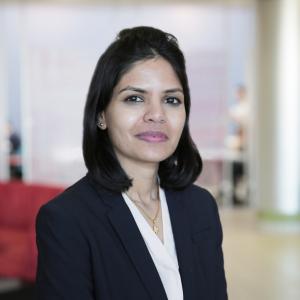
GREESHMA GADIKOTA
SUSTAINABLE ENERGY AND RESOURCE RECOVERY
Fossil fuels such as petroleum, natural gas and coal satisfy over 80% of U.S. energy needs, but are the source of over 90% of the country’s carbon dioxide emissions from human activity, according to the U.S. Energy Information Administration. Many argue that the only way to meet the growing demand for energy while mitigating the effects of fossil fuels on the climate is by developing a portfolio of technologies to capture, convert and store carbon dioxide.
Assistant Professor Greeshma Gadikota is researching novel ways to develop those technologies with a focus on capturing CO2 directly from the air and flue gasses. She is also investigating how to remove carbon from plastic products in order to produce clean fuels and useful materials for the construction industry.
Carbon mineralization—converting carbon dioxide into inorganic carbonates—is one approach being explored to address both research challenges. In January 2020, Gadikota published a paper in Nature Reviews Chemistry that investigated the feasibility of carbon mineralization and determined existing knowledge gaps in the science.
“The paper also identifies approaches to scientifically de-risk our understanding of these challenges, with the aim of scaling up technologies for hydrogen production with CO2 removal and CO2 capture and conversion to produce inorganic carbonates,” said Gadikota. “Both pathways are designed with the intent of integrating accelerated carbon mineralization approaches. This is a considerable shift from prior approaches of developing capture, conversion and storage technologies independently of each other.”
Using emerging synchrotron methods such as cross-scale X-ray scattering measurements and leveraging laboratory-scale techniques such as infrared spectroscopy, Gadikota aims to advance fundamental insights into advanced carbonate and clay chemistry, natural and engineered colloidal systems, valorization of industrial residues, and elemental recovery from natural and engineered substrates. Her research in these areas will ultimately inform the development of next generation resource recovery technologies for applications such as low-cost battery materials.
Gadikota is exploring ways to bring her technologies to market through the National Science Foundation I-Corps program and Cornell Engineering’s Commercialization Fellowship. Her graduate student, Meishen Liu, spent a fully-funded summer and semester as a Commercialization Fellow, studying market opportunities for an integrated carbon capture and production method to produce value-added inorganic carbonates from industrial waste streams.
“Applying knowledge to create transformative technologies is something that we teach our students to do really well. It is a pleasure to advise students as they move towards higher order learning,” said Gadikota, who this past fall taught Cornell’s Intro to Geotechnical Engineering course, which focuses on how to harness geological environments for emerging energy, environmental and civil infrastructure applications.
“That can include, for example, getting a better understanding of how we can harness soils or geomaterials to build resilient structures and engineer fluid-particle interactions for emerging energy and environmental applications,” said Gadikota. “Often, the scientifically interesting phenomena occur far from equilibrium dynamic conditions, so how can we quantify them?”
Gadikota’s work probing fluid-particle interactions to inform the development of new technologies in energy and environment was recently recognized with a Sabic Young Professional Award from the American Institute of Chemical Engineers. And she was recently named a Scialog Fellow in Negative Emissions Science by the Research Corporation for Science Advancement. The fellowship aims to tackle challenging multidisciplinary problems through the pursuit of innovative research—a goal that aligns well with those of the School of Civil and Environmental Engineering.
“Fundamentally, it’s about breaking some of these existing thought processes that are barriers to innovation and coming up with new ways of how we can collaborate to make the planet a better place.”
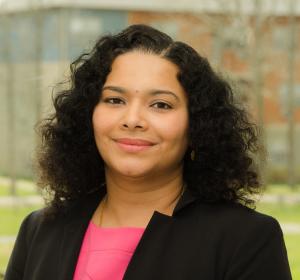
SRIRAMYA NAIR
SUSTAINABLE CEMENTITIOUS MATERIALS
Concrete is the most widely used human-made product in the world, so it is no surprise that improving its cementitious ingredients is an effort as old as concrete itself. Most modern-day concrete uses manufactured Portland cement, but Assistant Professor Sriramya Nair is researching novel ways to change how cement is engineered through the use of high-energy X-rays and magneto-rheology.
Rather than focusing solely on the chemical additives that can change the properties of concrete, Nair’s research incorporates magnetic particles into cement paste so that a magnetic field can be applied to control its rheological properties in real time.
Rheology— the study of the flow of matter—is a concept borrowed from physics, in which the flow and deformation of liquids, such as oils, can be controlled using stress applied by a magnetic field.
“By varying the intensity and the direction of the magnetic field, as well as the dosage of magnetic particles in the cement, you can go from a softer material to a peanut butter-like material, and you can keep going back and forth,” said Nair. “There are different applications where you want to be able to change your rheology and so it’s about real-time control.”
One of the applications Nair is researching is for well casings and plugs used in deep boreholes, such as those used for fossil fuel exploration or deep geothermal systems.
“Within the well, you’re trying to place cement slurry behind the casing where you don’t have much control,” said Nair. “But using an electromagnetic field and incorporating magnetic particles in the slurry, you can make sure you are cementing the entire cross section of the well, and not just one part.”
Nair is working with WellSet, a Norwegian startup that will soon be testing a prototype electromagnet to create cement slurries that could help adequately plug abandoned oil and gas wells. She is also researching how the magnetic approach can be used to create a better bond between 3D-printed layers of concrete.
Nair is also researching another physics concept: far-field high-energy diffraction microscopy, in which high-intensity X-rays produce extraordinary views of concrete at the microscale.
Stress tests are a common way structural engineers can gauge the strength of construction materials, but they do not offer a detailed analysis of how a product may deform, fracture or perform in any given environment. The microscopy performed by Nair can yield valuable data for optimizing the composition of traditional cement or other alternate cementitious materials, and for predicting their mechanical behavior.
“There are a lot of models out there trying to predict how a material would deform, and they all start on the micron scale because that’s where they are meshing their material, but they don’t have input data,” said Nair. “We can provide important information to feed into those models.”
The unique microscopy Nair is employing is enabled by the Cornell High Energy Synchrotron Source, where she was a postdoctoral researcher. CHESS is a half-mile ring buried beneath the south campus athletic fields, where electrons traveling at nearly the speed of light are directed toward materials in order to emit extraordinarily strong X-rays.
“The work we’re doing at the synchrotron is going to be very powerful in improving prediction models of alternate materials,” said Nair.
JACOB MAYS
STOCHASTIC OPTIMIZATION OF ELECTRICITY MARKETS
Behind every residential electricity bill is a complex, wholesale energy market—a system of tens-of-thousands of nodes and ancillary service products that, among other factors, determine the cost of electricity.
Electricity markets have evolved through the decades to foster competition and ultimately bring down prices. However, the evolution of those markets has centered around traditional energy sources such as coal and natural gas, and implicit assumptions based on those fossil fuels are embedded into market functions. This has made it difficult to integrate renewable sources of energy, such as wind and solar, into the grid.
Assistant Professor Jacob Mays is using stochastic optimization—mathematical modeling for decision making under uncertainty—to consider adaptations to market design that are needed to efficiently plan, manage, and operate an energy system that has a high degree of low-carbon resources.
“A lot of the challenge is how you manage the variability and uncertainty that accompanies that quantity of wind and solar generation in an efficient way,” said Mays. “So, you make sure that you manage the system reliably and make the best use of those resources that you can.”
One example of Mays’ work is published in a 2019 Nature Energy paper “Asymmetric Risk and Fuel Neutrality in Electricity Capacity Markets.” In it, Mays and colleagues detail an energy model that helps to structure tradeoffs between pricing and reliability in markets where renewable energy competes with carbon-generated power. They use stochastic optimization to develop new risk trading mechanisms that help overcome some of the characteristics of renewable energy that markets were not designed to favor. Examples include the higher fixed costs and near-zero operating costs of wind and solar, as well as the inherent intermittency of those energy sources.
“A big part of that is price signals,” said Mays. “If we’re trying to manage variability and uncertainty then signaling the value of the flexibility to respond to that variability and uncertainty is really crucial in order to get complimentary resources onto the system that can support wind and solar.”
Mays notes that it will take an interdisciplinary coalition of engineers, economists, legal scholars, and policy makers to play a role in the design and operation of an electrical system reliant on renewable sources.
His Nature Energy paper was recently cited in a report by the U.S. House Select Committee on the Climate Crisis titled “Solving the Climate Crisis: The Congressional Action Plan for a Clean Energy Economy and a Healthy, Resilient, and Just America,” and Mays said he is looking forward to working with policy makers and experts across campus on future research.
“As engineers, we know the mathematical and technological cores, but we have to be aware of the economics, the policy, and the legal aspects of energy to really do effective work,” said Mays.
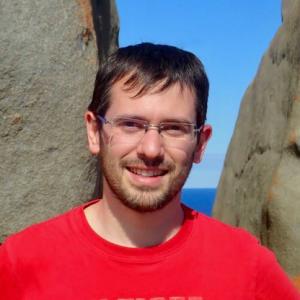
ANDREA GIOMETTO
ECO-EVOLUTIONARY DYNAMICS OF POPULATIONS
Microorganisms such as bacteria, algae and viruses are omnipresent in our lives. These microbes play a key role in the biological dynamics of just about everything on Earth, from human health and medicine to the environment to food and agriculture.
Assistant Professor Andrea Giometto studies the spatial eco-evolutionary dynamics of microbial communities— the way in which physical surroundings influence evolutionary changes in microbes. The foundational knowledge gained by Giometto on this small scale can be used to study much larger processes. For example, using gene drives to modify mosquitoes so they will not carry malaria, or predicting how an invasive species may spread in any given environment.
“What I’m doing is figuring out what are the conditions under which a population can successfully expand,” said Giometto, “or figuring out what are the dynamics that ensure that it won’t spread in an uncontrolled way. It’s a bit like when civil engineers make models of buildings at scale, except this is a living system.”
Giometto combines genetic engineering with theoretical modeling to understand how different microbes grow and interact with each other. At Cornell, he plans to continue a project he began as a postdoctoral researcher in which he developed two strains of yeast that were genetically modified to exchange toxins, controlling how much of these toxins they independently produce.
“In a way, I can look at a version of microbial warfare. Controlling the strength of the two opponents and looking into the spatial dynamics of this is something that people haven’t looked at,” said Giometto.
He is also evolving populations of yeast, selecting for cells that expand faster and looking at what kind of phenotypes emerge in these expansion experiments.
“I’m trying to figure out the parameters that matter between simulations of these cells that grow and push each other in these dense populations,” said Giometto, “and how the mechanical forces that they exert on each other affect the expansion.”
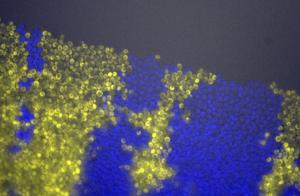
Giometto, who has degrees in physics and in environmental engineering, said that while there are many academic departments that could house a microbial researcher—ecology, evolutionary biology, microbiology—he feels civil and environmental engineering is the right fit for him. “People in environmental engineering have been dealing with microbial populations for a very long time and they need to have a quantitative understanding of how these things work in order to apply,” said Giometto, who hopes to collaborate with a variety of researchers from within the school, college and university.
“For any researchers wanting to manipulate the microbiome, you need to know what are the conditions under which you can successfully introduce or control a new microbial strain,” said Giometto. “One of the first things is doing these kinds of experiments.”
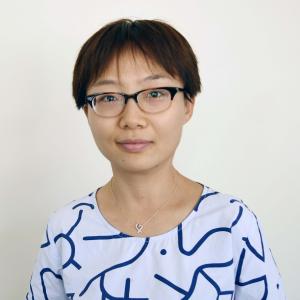
QI LI
FLUID DYNAMICS AND HEAT TRANSFER IN THE BUILT ENVIRONMENT
How can cities be engineered to be more sustainable and resilient in the face of climate change? That question is at the heart of research conducted by Assistant Professor Qi Li who applies numerical models to study how the built environment impacts land-atmosphere interactions.
“Urbanization is concentrating the world’s population, economy and resources in cities,” said Li. “Within the interconnected Earth system, we need to better understand the complex interactions between climate and the ‘urban metabolism,’ such that mitigation and adaptation can be implemented for the most vulnerable communities.”
In one project, Li is using large eddy simulations— mathematical models for turbulence—and satellite observation data to better understand the transport of momentum, energy, and mass in the lower atmosphere. The resulting data can help improve weather models for urban areas. In other research, urban environmental fluid mechanics modeling is used to study how microplastics produced in cities end up in the atmosphere, potentially being transported around the globe.

GREGORY MCLASKEY
EARTHQUAKE MECHANICS AND SEISMIC WAVES
Deep below the subsurface is a medley of rock faulting, friction and fractures all leading to seismic activity that provides clues to the complex physics and mechanics within the Earth.
Assistant Professor Gregory McLaskey studies this activity through the recording, measurement, and reproduction of propagating waves.“I basically make earthquakes in a lab,” says McLaskey. “I create conditions that are sort of similar to what happens a couple kilometers down in the earth by squeezing rocks. And I’m trying to do this at the biggest scale possible in a lab.”
Last year, McLaskey received a National Science Foundation Early Career Development Award to study the role of fluids in earthquakes, with the goal of better interpreting seismic observations such as tremors. He conducts this research using custom-engineered, biaxial rock-squeezing machines that can exert thousands of tons of force on a sample of rock, simulating deep subsurface physics.
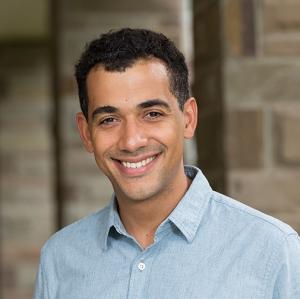
MATTHEW REID
CONTAMINANT TRANSPORT AND ENVIRONMENTAL TRANSFORMATION
Bacteria and other microorganisms living in soil are drivers of biogeochemical processes that, if harnessed properly, could lead to new ways of protecting environmental quality.
Assistant Professor Matthew Reid combines his expertise in environmental chemical and microbiological processes to better understand the soil microbiome and how it affects contaminant transport and toxicity in the environment. A major focus of his research group is understanding the controls on the chemical form of arsenic in the environment. For example, microorganisms in soil and water use enzymes to drive arsenic transformations, but for these changes to occur, arsenic must first be transported inside microbial cells.
“We’ve recently adapted a fluorescent biosensor method to quantify arsenic uptake into microbial cells, and that’s allowed us to learn how solutes in the extracellular environment—things like dissolved organic matter and other metalloids—affect the bioavailability and subsequent biotransformation of arsenic,” said Reid.
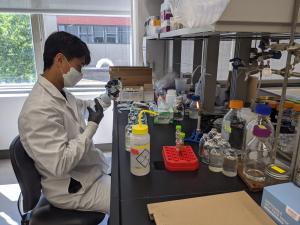
This research has applications to the transformation of the fate of arsenic in rice paddy soils, where uptake of arsenic into rice and contamination of the food chain is a growing concern. Through a new grant, Reid is also working with the City of Ithaca Water Treatment Plant to better understand how microbial processes in the reservoir sediments release manganese into the water column, which can lead to high manganese concentrations in the plant’s intake water. The goal is to predict periods of elevated manganese concentrations based on easily-measured environmental conditions so that plant operators can better treat the elevated manganese.
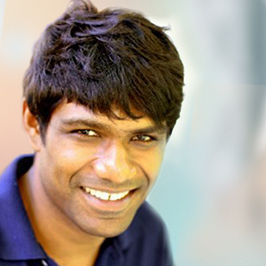
SAMITHA SAMARANAYAKE
MODELING, ANALYSIS AND CONTROL OF TRANSPORTATION NETWORKS
Technological advances in computing, communications and sensing have led to new opportunities to improve urban infrastructure systems, in particular the ubiquity of smart phones and GPS-enabled devices has led to many innovations in transportation networks.
Assistant Professor Samitha Samaranayake uses specialized algorithms and optimization techniques to develop new models for supporting the global need for affordable, equitable and sustainable personal mobility. For example, through exploring the possibilities for a new generation of hybrid transit systems that integrate traditional fixed-line public transit, such as buses, with demand-responsive transit, such as on-demand shuttle services. He addresses these problems through the lens of algorithm engineering— informing new practical algorithms through theoretical insights and vice versa—by exploiting domain specific characteristics that appear in transportation-related variants of classical optimization problems.
“While there has been a lot of activity in emerging mobility systems, they have generally not benefited public transit and have had a very limited positive impact on communities that rely on public transit,” said Samaranayake. “There is a huge potential for improving personal mobility for all by focusing on transit-centric mobility technologies. This can also help reduce the negative externalities associated with the transportation system.”
In another recent line of research, Samaranayake is modeling the impact of localized travel patterns and heterogeneous interventions on the spread of COVID-19 with collaborators from Weill Cornell Medicine, Vanderbilt University and Rutgers University-Camden. The hope is to understand how targeted controls of local mobility and other interventions can be used to mitigate the spread of infection while minimizing the economic cost of doing so.

